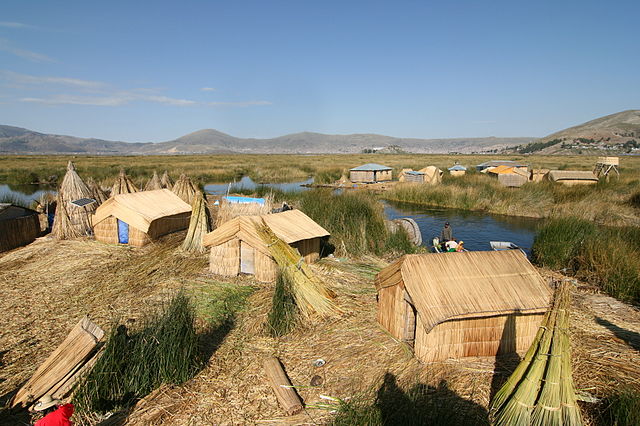Lakefront Property
Lake Titicaca, located in the Andes between Peru and Bolivia, is South America’s largest freshwater lake and a punchline for English-speaking grammar school students around the world. At an elevation of about 3,800 meters, it is considered by many to be the world’s highest navigable lake, although some smaller lakes are navigable by small commercial ships.
It is also home to roughly four dozen floating, inhabited islands made of nothing more than reeds, as seen below.

The islands are the creation of a group of people known as the Uros, whose history dates back to pre-Incan times. They live primarily on the Peruvian coast of the lake and on the islands they have created. The island (and their huts and boats) are made up of totora reeds, a tall, thick, grass-like plant which grows in the marshland there. When dried, totora reeds can be weaved together to create a rope-like material which holds up well when placed in water — and can act as a base for an island, the structure of a boat, or even the walls of home. An island of totora reeds can lasts twenty to thirty years. As the totora’s strength wanes, the Uru simply add more to the island’s floor.
The reason for the floating islands has been lost to antiquity, but the most common belief is that they are defensive structures intended to protect the Uru from invading Incans. The Incans would enslave any Uru they captured, so the Uru may have built the islands either as lookout stations (there is a watchtower on one of the larger islands) or perhaps as a place to make a safe retreat. Today, there is no such need — the area is part of Peru’s Titicaca National Reserve, and the Uros’ homes and culture are protected under that umbrella. (Their language and many of their traditions have been lost for centuries, due to intermarriage with another group in the area called the Aymara.)
Today, about ten Uru families live on each island. The unique character and composition of the islands has allowed for close living even when families quarrel. There’s an easy solution. As the Financial Times notes, “should there be disputes between families living on the same island it is easy to cut a single home off and float it to another island.”
More photos of the Uru and their islands can be found here.
Bonus fact: Totora grows in two places. It is native to Peru but also is found at Easter Island, 2,600 miles away. Easter Island, home of the well-known rock sculptures known as moai (these), is one of the most remote inhabited islands in the world. Early researchers believed that the presence of totora explained how people got there; as the thesis went, early South Americans made boats of dried totora reeds and set into the Pacific, landing on the island and then cultivating more totora there. But that thesis is almost certainly untrue. According to Wikipedia, a pollen analysis of the island shows that the totora has been on the island for 30,000 years, and was most likely brought there by migrating birds.
From the Archives: Nazca Lines: Another wonder from Peru.
Related: “Lines in the Water: Nature and Culture at Lake Titicaca” by Ben Orlove. 4.7 stars on three reviews, and available on Kindle.

Leave a comment